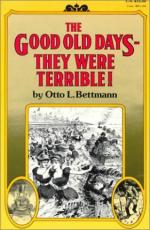
|
| Name: _________________________ | Period: ___________________ |
This test consists of 5 multiple choice questions, 5 short answer questions, and 10 short essay questions.
Multiple Choice Questions
1. Why were some animals a pollutant problem as noted in the chapter "Air"?
(a) They got in the way of street cleaners.
(b) They had way too much carbon monoxide emissions.
(c) The made noise pollution within city limits.
(d) Their manure made an awful stench.
2. Author Otto Bettman wished to shatter the misconceptions of the late 19th century by:
(a) Describing the westward movement.
(b) Reporting how the nineteenth century immigrants flourished in the New World.
(c) Reporting how glorious life in the late nineteenth century really was.
(d) Demonstrating what life was really like for average people.
3. How did the electric trolley car create even bigger traffic problems for cities?
(a) It was poorly scheduled.
(b) It was way too slow.
(c) Too many people wanted to ride.
(d) It was built on the busiest streets.
4. Just like their male counterparts, frontier women after the Civil War endured:
(a) Harsh weather.
(b) Back-breaking labor.
(c) Lack of voting rights.
(d) Small town life.
5. In the era after the Civil War, what was the most dangerous sweatshop activity?
(a) Cotton weaving.
(b) Loom operation.
(c) Tobacco stripping.
(d) Sewing.
Short Answer Questions
1. What was a popular type of big city housing during the late 1800s?
2. What problems did the railroads add to any town in the late 1800s?
3. Due to a lack of a sanitation department in the late 1800s, many streets in the large American cities were lined with what?
4. What was the name of the first vertical apartments?
5. According to Bettmann in "Housing," why did people keep their windows closed even in the heat of summer?
Short Essay Questions
1. According to the chapter "Air," what were some of the problems with using a streetcar for transportation?
2. In the late 1800s, were strikes an effective way to handle grievances by workers?
3. What was the area in New York that was the worst air pollution offender in the late 19th century?
4. What two things negatively effected the mental health of homesteaders?
5. How did railroads contribute to the pollution and danger for many cities?
6. What were some of the toxic inhalants many industrial workers had to endure in the post Civil War era?
7. Who constructed the first apartment building, and why was it created?
8. Was the fare for streetcars affordable to the working-class?
9. How did the apartments of the late 1800s often turn into death traps for its occupants?
10. How did landlords take unfair advantage of their tenants in the late 19th century?
|
This section contains 736 words (approx. 3 pages at 300 words per page) |

|




